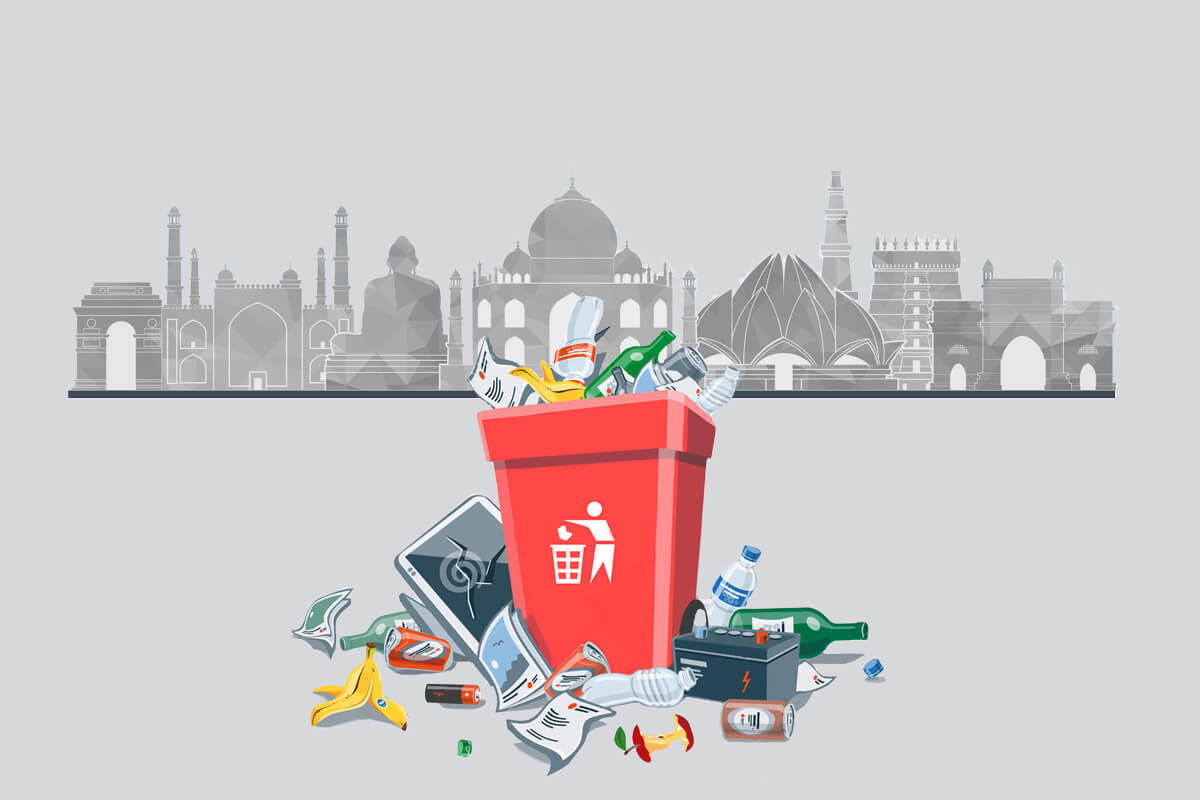Management of Municipal Solid Waste (MSW) has become a pervasive Achilles heel for most municipal corporations across the developing world. India, being one of the fastest growing economies and the second most populated country (with ~1.3 billion people) in the world, is not an exception.
Before doing a deep dive, let’s first understand what MSW means
Globally, MSW is commonly referred to as trash or garbage, which includes dust, leafy matter, building debris, and residential waste. It also consists of treatment plant residual sludge from various municipal activities like construction and demolition, street cleaning, landscaping, etc.

Around 40% of MSW constitutes of organic wastes that can be utilized through either an aerobic or anaerobic process to generate biogas, electricity, and compost. Another 45%, consisting of metal, glass, paper and plastics, is reusable or recyclable. The waste that cannot be processed can be utilized in gasification system technologies to reduce the volume and generate energy.
How MSW in India stacks against developed economies
India generates ~188.5 million tonnes of MSW daily. Delhi, the capital of India and also one of the most densely populated cities, generates around 9,000 tonnes/day of MSW. 70% of the total MSW produced is collected; while only 13% is either processed or treated.
Though India has implemented rules and regulations w.r.t. MSW, the country still faces multiple challenges in dealing with the current situation. Handling such a massive amount of waste with respect to its collection, transportation, separation, segregation, treatment & disposal remains a herculean task.
MSW concerns are growing
MSW dumped on open lands creates various social and environmental issues. The waste creates foul smell, vermin, loss of aesthetics, leachate that eventually ruins the groundwater while the run-offs from the dump-yard pollute adjoining freshwater-bodies. Consumption of this water can lead to several water-borne diseases and can be deadly. Further, this leads to the generation of methane, a greenhouse gas that is 21 times more potent than carbon dioxide.
Also, the common practice to collect garbage off the streets and burn it in the open worsens air pollution. People in the cold weather burn this garbage, that consists of leaves, paper, cardboard, twigs, plastics and even rubber tires, to keep themselves warm. As a result, this ignorant action results in smog leading to respiratory diseases.

The challenge at hand: Since the amount of waste generated is more than the processed or treated waste; the disposal of MSW is an issue of serious concern for Indian officials as the country is running out of space for MSW management. However, the core issue is not limited to the disposal of MSW but also its effective treatment with minimum environmental damage.
Recent government initiatives
The Government of India (GOI) has taken some proactive steps to raise the sanitary levels of the country. In Oct 2014, the GOI introduced ‘Swachh Bharat Abhiyaan’ (or Clean India Mission) covering 4,041 statutory cities and towns; to achieve waste to energy; waste to compost; and 100% door to door waste collection.
Through this initiative, the Indian government aims to achieve an Open-Defecation Free (ODF) India by 2 October 2019 by constructing 12 million toilets in rural India, at a projected cost of INR1.96 lakh crore (US$29 billion).

Possible solutions
- Create awareness: The Indian government’s primary step would be to create widespread awareness of the current MSW scenario. Foremost, the country should aim to make all citizens understand the growing need for active participation across all levels.
- Proper planning: The government needs to allocate dedicated secure zones (station/depots) to handle and segregate wastes; build infrastructure; and deploy manpower to manage the daily waste.
- New regulations (including penalties): The regulator needs to impose directives for the segregation of wastes; utilization of organic wastes for composting; and recycling of other waste materials such as metals, plastics, paper, and glasses.
The implementation of stricter policies for segregation, separation, reuse, and recycling could reduce the amount of MSW, that has to be dealt with, down to 15%. This remainder could be treated by Plasma Arc Gasification (PAG) units, further reducing the volume and creating electricity in the process. The residual molten slag could be homogenized and put into molds to make pavement bricks and tiles.

Plasma Arc Gasification (PAG):
Definition: PAG technology is a type of Refuse Derived Fuel (RDF) that generates energy from waste material and leaves an environmentally benign and vitrified residue that can be used for construction activities.
This technology invented by NASA in the 1950s is widely adopted and used in developed economies such as Taiwan, Japan, China, United States of America, etc. but as it is considerably expensive, developing economies are far from reaping the benefits of such a high-end technology.
Plasma pyrolysis system, one of the pilot prototypes developed in Gujarat can treat 15-20 kg of hospital waste per hour. This technology may also require the electrical power of around 670 units (kWh) to convert MSW into vitrified solids and metals; hydrogen and carbon monoxide gas. Yet, the cost associated with this prototype stands at INR 1-1.2 million which limits its active adoption. Also, the net operational cost after the sale of byproducts is estimated at INR 750 per tonne of waste.
Economic opportunities that the government can capitalize:
- MSW treatment technology start-ups: The country’s policies on waste segregation, utilization of organic wastes; and recycling waste material presents a huge opportunity for start-ups operating in the area of MSW management.
- FDI Inflow: FDI inflow in India will boost the cause and help the country to address the MSW menace in the near future.
- Public-Private Partnership: Government’s association with the private firms will also aid the initiative to tackle MSW.
To learn more about global environmental challenges and their probable solutions, please request a free consultation and engage with our ESG Research Experts.









